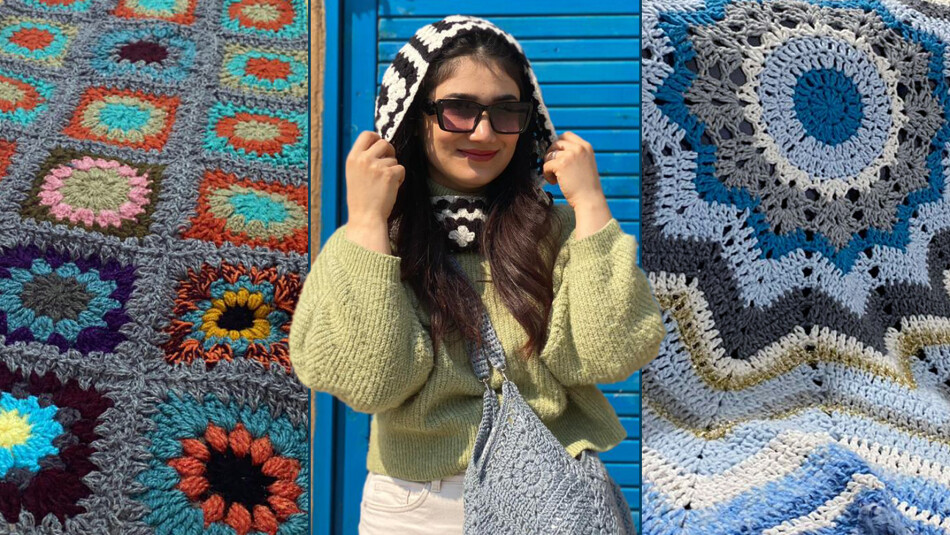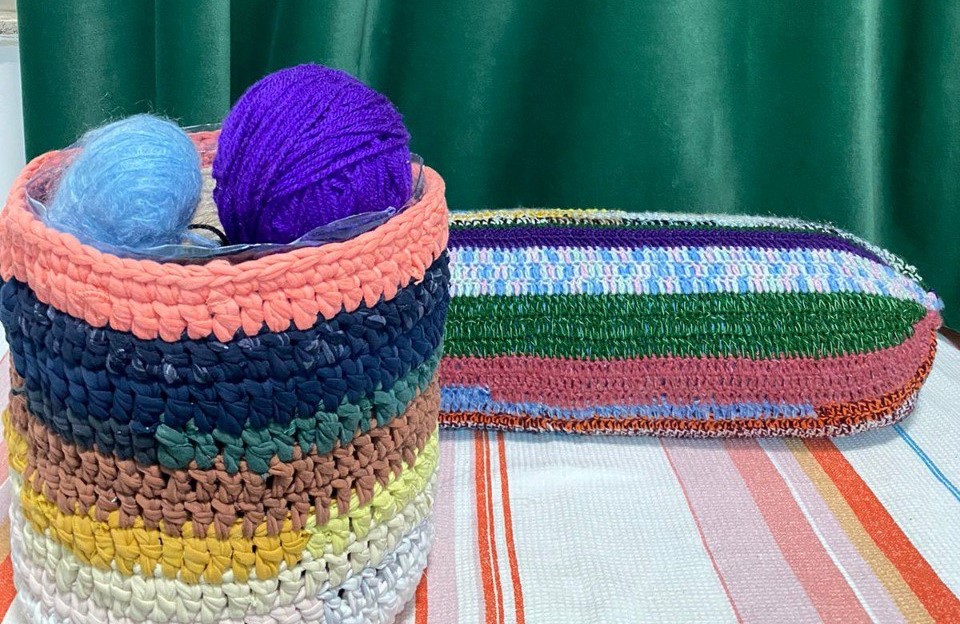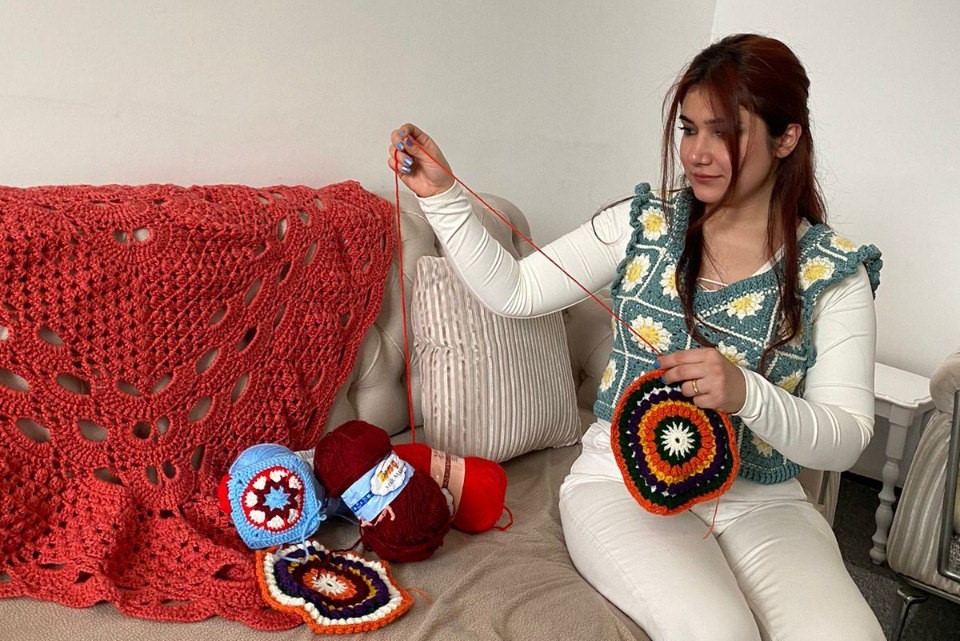
Your wool coat is worn out and you no longer wear it? No problem, and there is no need to throw it away as long as Nina is there, as she will re-produces new pieces from it.
The work of this young woman from Sulaimaniyah is considered art and at the same time a favor to the environment, because she reuses and recycles wool clothes instead of throwing them in the trash can.
The random disposal of used woolen clothes is a cause of pollution, since they are often thrown into water sources in villages such as rivers and springs.
“This piece of clothing was damaged due to the use of stain remover, but instead of throwing it away, I re-weaved it and made a pen holder out of it,” according to Nina, who indicated that she reduced spending on cosmetics and decided not to be a reason for increasing the amount of waste.
Elegance does not require buying a lot of clothes and accessories, and the United Nations urges people to reuse their belongings and possessions, for example by making new pieces from used and old clothes, to preserve the environment and reduce waste.
Old art with modern flavor
Nina’s memories with her grandmother were a source of inspiration for her. She used to watch her grandmother reuse worn-out clothes or woolen fabrics to make covers, pillows or mattresses.
“The memories of the past became a source of inspiration for me to reduce expenses and not contribute to the increase in waste, by making use of old clothes to produce new pieces.”
Nina Adnan Karim, 29, learned knitting, using knitting needles and a ball of wool that her sister earlier bought, but got tired of using it. However, Nina did not give up on the idea making it the start of her success story. Nina enjoys a great talent in knitting and now runs her own business.

Most of the items Nina knits are household items and decorative items, Sulaimaniyah, 2024. KirkukNow
“I do not turn used clothes into other pieces of clothing lest they cause harm, but I make decorative items out of them.”
Nina first unwinds the wool into threads, which she rolls into balls and then uses her knitting needles and talent to produce new items, such as bags, hats, scarves, shawls and other items.
The United Nations estimates that every second, a truckload of clothing is sent to landfill or burnt, and less than 1 percent of the materials used in the fashion industry are recycled into new items.
“We play a major role in preserving the environment through our work. Every home has plastic bags, but I have made wool bags and a doormat for our home. Overall, the items I make are useful in many ways,” Nina explains.
One of Nina’s sources of raw materials is the secondhand clothing market. Nina buys only clothes of one color, meanwhile the wool threads should be relatively thick so that they do not break during unwinding. After unwinding the wool, she washes it.
“I often make decorative items instead of clothing.” The wool from which clothing is made goes through different manufacturing stages until it becomes fabric. According to United Nations statistics, producing a kilogram of fabric is responsible for pumping 17 kilograms of carbon dioxide into the air.
Shahla Tahir, owner of a secondhand clothing store in a Sulaimaniyah neighborhoods, noticed that there was a constant demand for wool clothing. At first, she thought people were buying it to wear, but later she discovered that “a small percentage of these clothes were worn, the rest was used to produce other items. For example, one woman was buying it to make bathing loofahs.”
Another group of Shahla’s customers were buying old wool clothing and were reusing it to knit shawls, scarves, gloves and bags. “If the piece of cloth was very old, I would sell it to them at a lower price.” Shahla says that these handicrafts cost less and last longer.
A source of income for her and a benefit for others
Nina has come a long way in refining her talent and is thinking of teaching others her profession besides promoting her work.
Nina learned knitting skills via YouTube videos which she benefited from a lot, “My goal now is to sign an agreement with an organization to open special courses to teach women knitting skills.”

Nina Adnan while knitting a new item, Sulaimaniyah, 2024. KirkukNow
Nina previously participated in a shopping fair, in coordination with an organization, and sold many of her products and allocated half of its revenues to charity. She also participated in a number of exhibitions, events and other public occasions.
Nina created a page for her work on Instagram, where she displays and sells her products, however, she believes that her work needs more promotion.
Using wool is not something new, as it has been used for a long time to make mattresses, pillows and some other items, but reusing wool obtained from old clothing items to make new ones is rather new.
Hazha Abdullah, a customer of Nina’s products, says, “I love knitting and handicrafts, especially to support people who work at home.” When Hazha learned that Nina was reusing old clothes to produce new items, she decided to bring her old t-shirts for Nina to make new items.
“I didn’t know what to do with the clothes I stopped wearing. If I threw them away, they would pollute the environment and become waste. I collected them and took them to Nina, she turned them to colorful baskets that I now put in my house,” said Hazha.
More than six thousand tons of household waste are collected daily in the Kurdistan Region, the vast majority of which is not sorted, including old clothes, according to Kurdistan Region’s Statistics Office.
Shahla Tahir says that there are other ways to reuse used clothes. Some of her shop’s customers buy large pieces and re-design them to fit children or use the patterns on used clothes to design other handicrafts.
There are also some clothes that are not accepted by the society, so they use their fabrics to produce other items of clothing.
Polyester is used in the manufacture of a large part of the fabrics currently available in the markets, and polyester takes 200 years to biodegrade.
Ayshin Karim, 60, has been making pillows and mattresses at home for years, “This type of pillows and mattresses is more comfortable and healthy compared to those you buy from the market.”
Ayshin reuses any old items of clothing she finds in her home to make other pieces. The old items she reuse are not necessarily from wool or cotton.
The head of the Ayinda (Future) Organization for Environment Protection, Marouf Majeed, supports attaching importance to heritage, as Kurdish families used to take their old clothes to the cotton corder to make pillows and mattresses out of them, “In the past, clothes did not turn into waste and were of higher quality. The clothes currently on the market are made of nylon, which is harmful to the skin.”
Textile waste is one of the main causes of environmental pollution, especially in poor countries where people are unable to buy high-quality clothes and buy whatever is cheap which could be used for a short amount of time, according to Marouf Majeed.
In a move aimed at reducing textile waste, Ayinda Organization has suggested to the KRG Ministry of Education in recent years to implement mandatory school uniform clothing.
The beauty of her products makes her forget tiredness
Nina's mother did not support her daughter's project, not because she did not want her to succeed, but because she feared that her daughter would gain nothing but tiredness, assuming that she would not earn enough from selling her products.
But Nina thinks differently, when she sees how her handicrafts add beauty to the house, she forgets her exhaustion, “What encouraged me to continue is that the decorative items in our house are made by my own hands, anyone who visits our house asks me to make the same for them.”
Kurdistan Region markets do not provide a suitable environment for developing handicrafts, including knitting. They are flooded with imported clothes, some of which are much cheaper than local hand-made products.
The head of the Ayinda Organization for Environmental Protection says that there are no serious efforts to reduce clothing waste, there are small attempts that need to be expanded and other measures that should be taken, “such as not allowing the import of low-quality clothes made of nylon.”
The fashion industry ranks second among sources of environmental pollution after the oil industry. United Nations Environment Program Statistics indicate that this industry is responsible for 10 percent of the total carbon dioxide emissions worldwide annually.
Carbon dioxide is one of the factors behind accelerating the effects of climate change, as Iraq is ranked fifth among the countries most affected by the impacts of climate change.
Donating clothes to the deprived is one of the initiatives implemented in the Kurdistan Region, and Marouf Majeed encourages such initiatives to protect the environment.